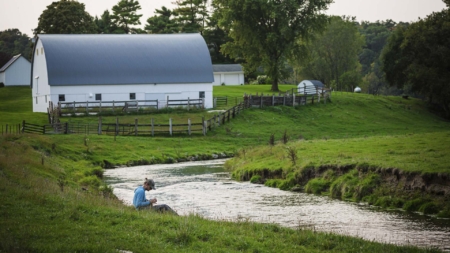It’s All Home Water: Mississippi Clean
The Big Muddy is polluted. Securing the Driftless Area can help clean it.
All photos by Hansi Johnson
Minnesota kids learn about the Mississippi River early. I learned to spell it melodiously in grade school, and I rock-hopped across its northern Minnesota headwaters on family camping trips. In college, it was the boundary between the University of Minnesota’s East Bank and West Bank campuses. In recent years, I’ve caught muskies from drift boats in its forested, bouldery upper reaches. But the mighty Mississippi, the river of Huck Finn and paddlewheel boats, the river that drains most of the continent, remained an abstraction.
This past fall, I finally got it. On a fishing trip with a houseboat as our mothership, some friends and I fished and explored the Mississippi and its labyrinthian backwaters near Winona, Minnesota. We were still in the uppermost part of its watershed. Still, I was overwhelmed by the scale of the system as we buzzed our skiffs up and down the channel in the shadow of mountainous limestone bluffs and worked deep into the interlaced backwaters of the jungled floodplain.
We caught a lot of fish. Mostly smallmouth bass and northern pike, with some largemouth in the slower water. We saw bluegills and walleyes, gulping longnose gar and various minnows and baitfish in galactic schools, their names known only to academics. The river is also a major migration flyway, and the skies and trees were as alive with life as the water.
Yet every time we rounded a main river bend or popped out of a side channel, the other shoe dropped. Or rather, stomped down. The steel-toe boot of industry has trod a permanent trail on this riverway. The current is corralled by thousands of century-old rock wing dams that extend from each bank. The navigation channel is continuously dredged to maintain passage for millions of tons of cargo per year, floated up and downstream on a continuous train of massive, tug-pushed barges. A mammoth series of locks and dams regulate flow. It severs the river into artificial segments, choking off the respiration that a naturally rising and falling river system requires.
And, of course, there’s the water itself. The Clean Water Act has helped reduce pollution from “point sources”—think of a factory drainpipe dumping fouled water right into the river. But “non-point sources” of pollution, like agricultural runoff, remain a complex problem. The river runs clear and clean in northern Minnesota, where the landscape is mostly forest and wetlands. But the central part of the state is mostly farmland. By the time the Mississippi reaches the Twin Cities, it fails the Minnesota Pollution Control Agency’s river life and recreation criteria. Phosphorus, nitrogen and sediment are the primary pollutants, which choke and over-fertilize the river and its residents.
And that’s just Minnesota’s portion of the river. Thirty more states lie within the watershed, each contributing its own agricultural pollution. All this nutrient-rich water gets dumped into the Gulf of Mexico and causes massive algae blooms that deplete the water’s oxygen, forcing fish, shrimp and other aquatic life to either leave or die. This hypoxic “dead zone” in the Gulf averages about 5,300 square miles but has grown as large as almost 8,800 square miles.
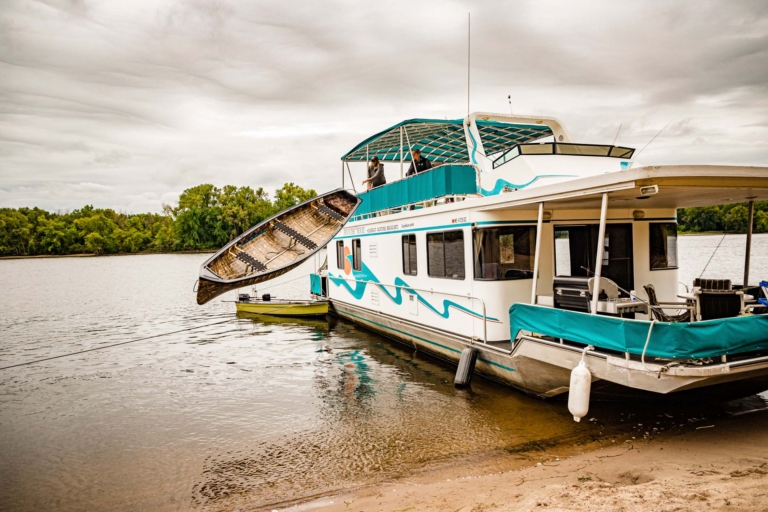
Brian Porter and Willie Rahr air launch a skiff from their Mississippi mothership. These small, maneuverable boats are the perfect conveyance for the shallow, weedy and bass-filled backwaters of Big Muddy.
This story, like all stories, really begins in the headwaters—not just the Mississippi’s traditional headwaters at Lake Itasca but also the headwaters of each small tributary trickle. And in southeast Minnesota, where we beached our houseboat last fall, these trickles all have trout in them—or should.
Each of the towering bluffs along the river here is a peak between steep valleys. Cold streams run and meander, draining an entire network of hills and valleys fed by ancient mineral-rich aquifers. This is the Driftless Area: the Midwest’s pastoral spring-creek haven.
The Driftless got its name in a reductive way. The great ice lobes of the most recent glacial period missed it, having scooted to either side, and did not bury it in millions of tons of sand and gravel known as glacial drift. Instead, the delicate loess topsoil and karst-limestone bedrock have been gently eroding over tens of thousands of years. Today, it exists as a small, upside-down mountain range of steeply incised valleys on the four-corners borders of Minnesota, Wisconsin, Iowa and Illinois. The Mississippi cuts through its center.
Here live trout. Primarily brown trout, these days, though brook trout are the native fish and persist—or restored populations do—in many stretches. It’s a green idyll of meandering cow-pasture creeks, thickly wooded hillsides, blanket caddis hatches and some of the best terrestrial fishing in the country.
An angler fishing the Driftless can quickly see that it, too, has suffered under the plow. Instead of the once rich topsoil that made the region so attractive to settlers, fine brown silt chokes the streambeds. Much of it was once on the tops of the hills, but when settlers cut the trees and plowed the prairie, it quickly washed down into the valley floors, burying the gravel and rock-bottomed streams. The streams now cut brown ribbons into this soil, winding through corn and bean fields and cow pastures, sometimes 10 or 15 feet deep.
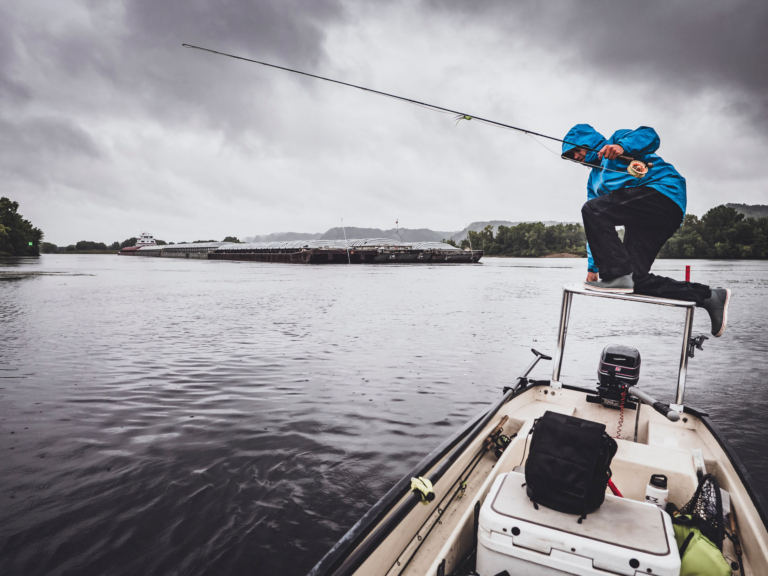
From Minnesota to the Gulf of Mexico, barge traffic on the Mississippi River is unrelenting. If you’re scouting from atop a fishing tower, barge rollers can add a bit of moisture to your day. Brian Porter prepares for an incoming swell.
Erosion, and the resulting pollution, remains a constant issue. A quick summer rain can ruin a weekend of fishing as the streams flash into muddy froth. Driving from spot to spot, an angler will see fresh washouts and gullies at every corner, cattle lounging right in the streambeds and row crops on almost all the tillable land—right up to the edge of a narrow riparian buffer.
It’s for this reason that most of the trout in the Driftless are brown trout. They are more tolerant of warmer, nutrient-rich water than the native brook trout. Brook trout do persist, especially where the water is still cold: in the upstream reaches of the streams, where the valleys are too narrow to farm and remain forested.
Over the last 50 years better farming practices and reforestation of the hills have reduced erosion and improved aquifer regeneration. Across the region, groups like Trout Unlimited, in concert with the Minnesota Department of Natural Resources (DNR) have done a massive amount of bank stabilization and habitat work. These days, the Driftless probably has more trout per mile than at any time in living memory.
But the scope of this work is limited because over 95 percent of the land in Minnesota’s Driftless region is privately owned. This is where groups like the Minnesota Land Trust come into play. The Land Trust is a nonprofit group that works with private landowners to protect and restore the conservation values that their property offers.
I spoke with Nick Bancks, the former associate director of land protection at the Land Trust, about their work in southeast Minnesota.
The land ownership issue can be a significant roadblock to conservation efforts. Local county boards generally resist the sale or donation of land to the state. Landowners themselves are often reluctant to work with state or local government agencies, from the DNR to their local soil and water agency. This is especially true when they see the efforts as simply more rules and regulations that impact their livelihoods, Bancks said.
Working with the Land Trust, however, allows landowners to retain control over their property.
“They don’t view us as a regulatory agency,” Bancks said. “We’re more of a partner rather than an antagonist.”
The Land Trust works primarily by purchasing conservation easements from landowners. The specifics vary, but generally, an easement places restrictions on future development and facilitates conservation work. Landowners retain ownership rights but sell—or donate—the easement to the Land Trust, which stays with property in perpetuity, regardless of ownership changes.
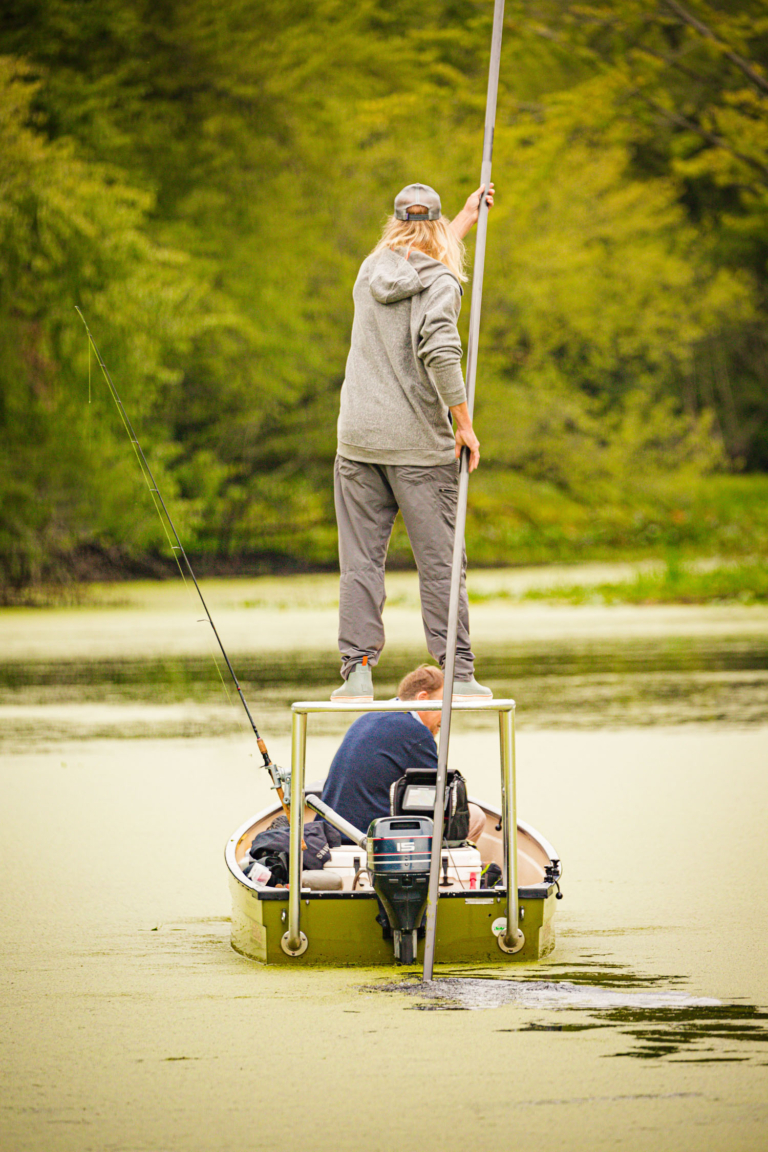
The sloughs of the Mississippi River are an ever-changing angling challenge. One moment they are alive with the current and smallmouth bass, the next they are full of duckweed, pike and largemouth bass. Searching for something fishable, Brian Porter poles Willie Rahr to open water.
With easements in place, the Land Trust can partner with the DNR and other government and non-government groups to develop plans and goals for conservation and restoration of native habitat. This work ranges from site design, sourcing funding and hiring contractors to do the work to the long-term legacy protection that an easement provides.
“We’re really trying to keep the landscape connected and natural, in a certain sense,” Bancks said.
The example Bancks pointed me toward is East Indian Creek, a small watershed near Weaver, Minnesota, that drains directly into the Mississippi. He had me talk with Larry Gates, who owns a farm along the creek, and has been working with the Land Trust to restore and protect ecosystems on his property.
“It’s not novel or inventive kind of work,” was one of the first things Gates said to me. He’s a practical, matter-of-fact speaker, good at distilling complicated habitat issues into what’s often a simple but hard and dirty job.
The Driftless contains many small, unique ecosystems, and they all need different kinds of help. The west- and south-facing bluff-side prairies, for example, are critical habitats for a variety of native birds, insects and one of Minnesota’s venomous snakes, the timber rattlesnake.
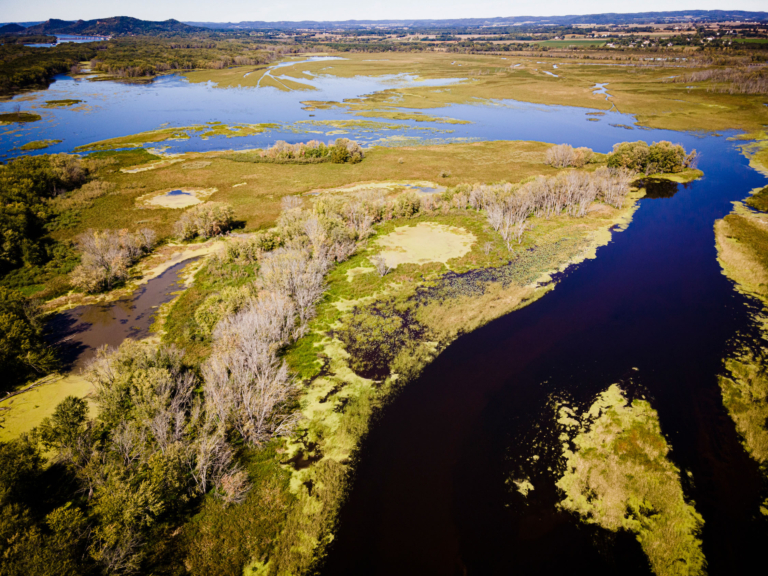
If you’re willing to put in the hours and investigate what the creeks, bends and sloughs of the upper Mississippi River conceal, you’re apt to come face to face with one of more than 100 varieties of fish: including bass, pike, gar, panfish, bowfin, drum, catfish, walleye and even trout.
Due to decades of fire suppression, these bluff prairies are choked with red cedars—a native tree, but not in that habitat. So, you need to cut the cedars and use controlled burns to keep them out, Gates told me. Other projects that he has been working on include widening and improving stream buffers along croplands, retiring some croplands altogether and planting native trees and grasses.
“It’s meat-and-potatoes conservation,” Gates said. “All of which is intended to diminish the impacts of agriculture” on the landscape and on the streams.
He said it’s all about ompressing the hydrograph, which means increasing a stream’s base flow—its groundwater inputs—and stabilizing its high and low flow periods throughout the year. Lower highs and higher lows. Having the proper native vegetation in its appropriate places on the land helps rainwater filter into the aquifers, rather than simply run off into the stream, which means less erosion and less agricultural pollution getting into the stream.
“You get cold water moving into those streams, you remove the flashiness, improve those base flow conditions, you’re gonna get more trout,” he said.
Of course, the restoration work has impacts beyond trout. When native plant regimes take hold, other wildlife tends to return to use the landscape. The East Indian Creek watershed is sandwiched between tracts of state lands to the north and south. Gates said its restoration can improve its function as a corridor for wildlife movement.
In recent years, Gates has seen an increase in wildlife on his farm, including bears and bobcats, a fisher and various native snakes—but no timber rattlers yet.
Gates, of course, is not the only landowner in the East Indian Creek watershed. He’s been working to recruit the others, sending postcards and demonstrating the restoration work underway.
“They plant some trees, steward the trees, take care of some exotics, they start to look at their land and appreciate it,” Gates said. “Hopefully [they] move into the arena of long-term protection. Make sure that investment of stewardship in the land continues to be passed on.”
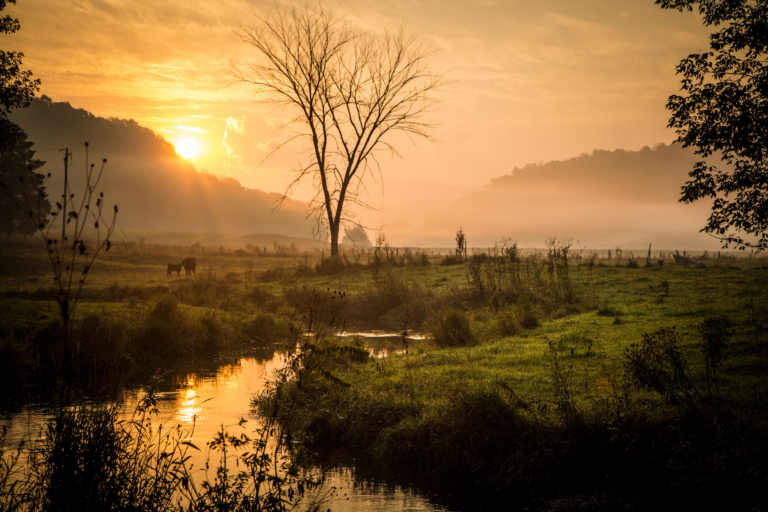
A small stream in the Driftless wakes gently, but don’t be fooled by its serene bearing. Success here demands the ability to read inscrutable water, stick flies into miniscule pockets and control fickle drifts in maddening microcurrents.
Gates is good at explaining this stuff: He’s a retired Minnesota DNR fisheries biologist and has been working with East Indian Creek since his time with the state, starting back in the 1970s—long before he owned the farm on the creek.
His work includes the DNR’s long-term tracking of flow, temperature and trout population on East Indian Creek. A recent study that collected data spans from 1981 to 2017 suggests that all this work to improve the river, from early shifts in land use to the modern restoration work, is having an impact. As the stream’s base flow—that cold spring water—has increased, brown trout numbers have been going down and brook trout numbers are going up.
And they’re special brook trout. The brookies in East Indian are a strain that the DNR’s genetic work has shown to be very likely Minnesota’s native fish—not just generic hatchery brook trout, which have been widely stocked in the region. They might have origins from as far away as the East Coast.
John Hoxmeier, a research scientist with the DNR and one of the authors of the East Indian Creek brook trout study, told me that the brookies’ recovery and the decline of the browns is a good sign. While adaptable and sporty, brown trout just aren’t as resilient once the streams return to a more natural state. The brook trout are.
“[Brook trout] are only going to survive and do well in the highest quality streams,” he said. “They’ve adapted to these conditions, so they’re the best suited for these streams.”
In this way, the brook trout are essential as the “proper” quarry for fly anglers and as an indicator species that the stream itself is healing, Hoxmeier said. If the brook trout are thriving, other native species are likely to be thriving as well.
He added that as climate change starts to erode the places where brook trout can survive—including northern Minnesota and Wisconsin—if we can keep the Driftless streams cold, they can hang on here.
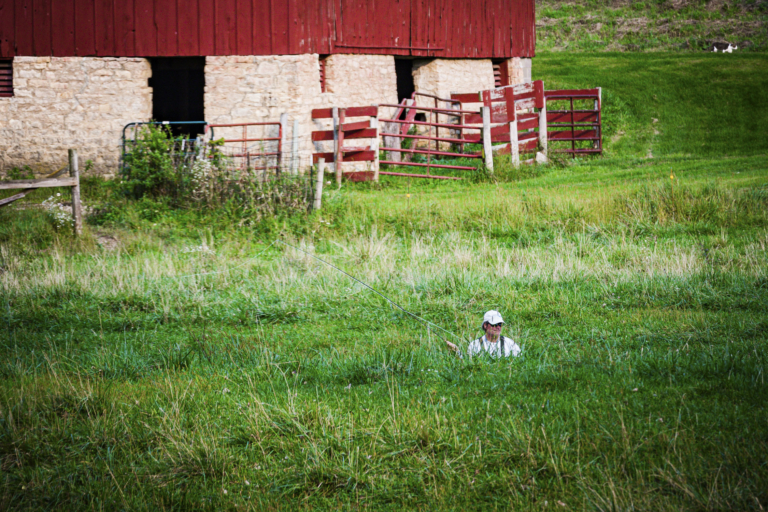
Waist deep in the Minnesota Driftless, Davis Fansler works a section of creek that has seen extensive restoration work along with rebounding trout numbers.
I’ve fished East Indian Creek. It’s tough. It’s a very small stream with deep, un-wadable bends and no room to cast. There are lots of trout, mostly small and usually visible, shooting for cover as I wade upstream in the ultra-clear, ice-cold water. On either bank is a buffer of thick brush and maple trees, then rows of corn and towering wooded bluffs. It’s hard to reconcile that the Mississippi is just a few miles downstream, with its bayou-like backwaters and heavy pollution load.
But that pollution comes from streams like this one; thousands of them. And if we take care of those streams, the Mississippi might just start to take care of itself.
